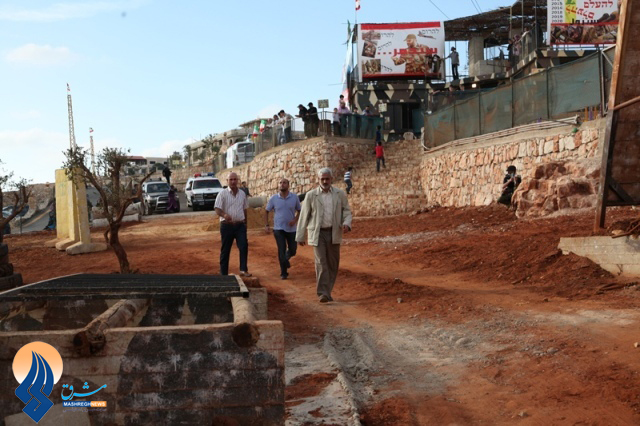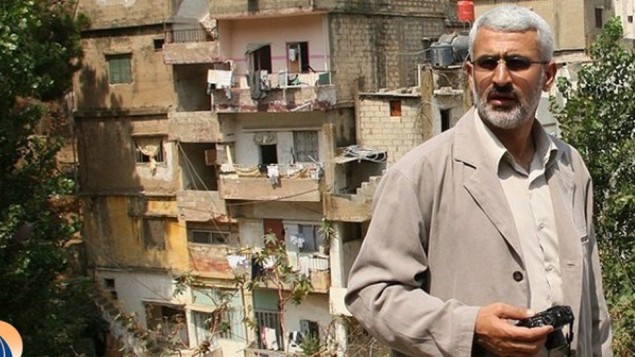Hard-line Mashregh News' tribute photograph to Revolutionary Guards commander Hassan Shateri
Joanna Paraszczuk writes her first analysis for EA:
The Iranian regime has continued this week with high-profile commemorations of Hassan Shateri, the Islamic Revolutionary Guards Corps commander whose death in Syria was announced last week. On Tuesday, prominent military and political figures --- including Speaker of Parliament Ali Larijani --- spoke at a celebration of "Martyr" Shateri's role in the reconstruction of Lebanon after the Israeli-Lebanese War of 2006, his career as an engineer, and his religious devotion.
At the same time, Western analysts devoted equal effort to speculations on whether the attention given to Shateri following his death indicated that he was involved in more than reconstruction. That speculation was fuelled by the comment of cleric Alireza Panahian, a disciple of the ultraconservative Ayatollah Mesbah Yazdi, that Shateri as "no less than Imad Mughniyeh", the Hezbollah commander assassinated by Israel in 2008.
Iran analyst Meir Javedanfar, writing in Al-Monitor, suggested that Shateri must have been in Syria for purposes other than building work, "It's very difficult to believe that Shateri was there 'to implement reconstruction and development projects', as the Iranian government claims."
The US-based Soufan Group asserted that Shateri's death "makes clear that the use of proxies in the Syrian civil war continues unabated", linking it to last autumn's statements by Guards commanders that their personnel were involved in Syria, albeit in a non-military role.
So was Shateri, killed --- possibly by an Israeli airstrike on a military convoy in late January --- as he travelled back to Lebanon on the Damascus-Beirut highway, part of an escalating involvement by the Iranian military in the Syrian conflict?
Let's start with this: despite the speculation, Shateri's role in the reconstruction of Lebanon, which includes connections with Hezbollah, is not in doubt. The Iranian media has published, before and after Shateri's death, photographs of the commander at projects in Hezbollah-dominated southern Lebanon, where he oversaw an extensive rehabilitation programme.

Indeed, it is that role as a Guards general martyred while on active duty as an overseas reconstruction engineer that is the real significance of this case. It symbolises Iran's ability to project its soft power and influence not merely outside its borders, but right up to Israel's frontiers with Lebanon and Syria. Shateri represents Tehran's political links with "the resistance" in both countries.
Then there is the symbolic significance within Iran, as Shateri's martyrdom is used to bolster the Revolutionary Guards. Over the past week, he has been eulogized first as a veteran of the Holy Defense -- the Iran-Iraq War of the 1980s --- and next as a religious man, someone who "never forgot to pray".
Hojatoleslam Ali Shirazi, the Supreme Leader's representative to the Qods Force of the Guards, said that Shateri was considered one of the IRGC's leaders, a vital figure in Iran's efforts after the 33-day war between Israel and Lebanon in 2006. He had selflessly gone to Beirut, despite its distance from Iran -- to help the Lebanese people reconstruct the country, representing the Revolutionary Guards' export of revolution via personal sacrifice. He was "Engineer Hassam", the folk hero not just for Shia Muslims outside Iran but also for Christians and Sunnis.
As Iran resists the enemy and its malicious designs in the Middle East, Shateri had become the honourable sacrifice not only to Israeli aggression but also to Western "terrorism" and interference in Syria. IRGC Deputy Commander Hossein Salami threatened that Iran would take revenge on Israel for the death of Shateri, praised for his religious fervour and purity: "He was also a man of the people, considering himself one of the ten million strong Basij [militia]." The commander of Guards unit in Greater Tehran, Brigadier General Mohsem Kazemeini, vowed that Iran will "certainly answer the Zionist Regime's terror attempts", with the Lebanese people would continuing the "resistance".
So the death of the Revolutionary Guards commander is not a give-away to a military surge by Tehran inside Syria.
Instead, Iran's creation of the symbolic "Martyr Shateri" is something far more, beyond Syrian borders. It is part of a continued drive not only to maintain but to extend a presence in the region, even as its future alongside the Assad regime looks increasingly uncertain.
It is the attempt to maintain a narrative, at home and abroad, of the Islamic Republic as an exporter of the revolution beyond its frontiers, pushing its power right to the doorstep of its existential enemy, Israel.
